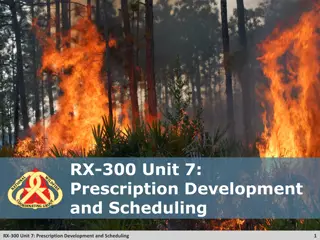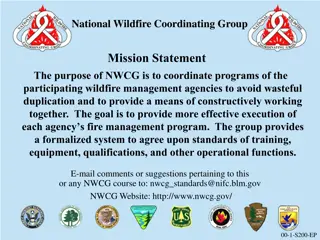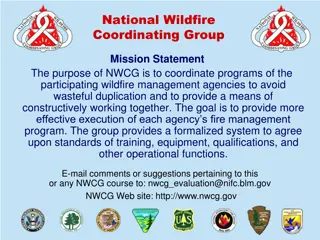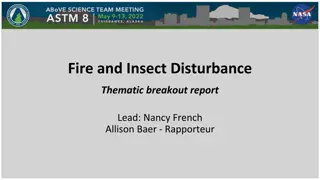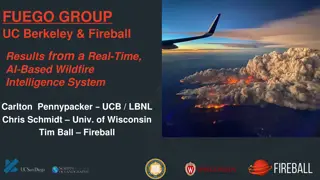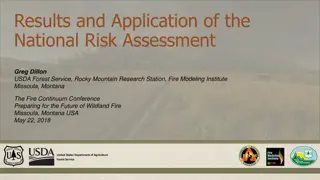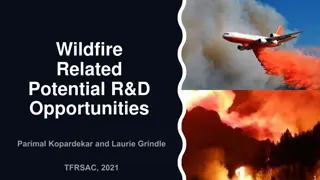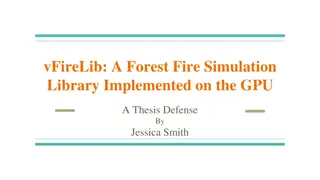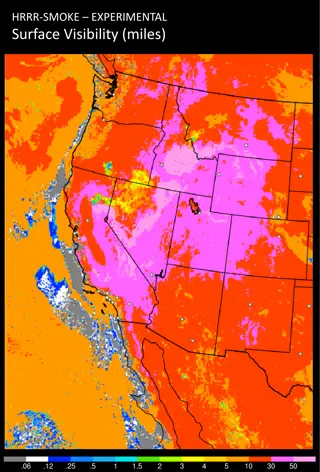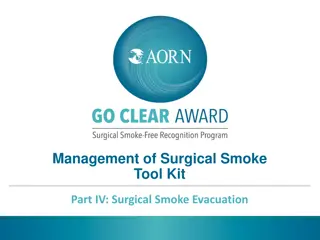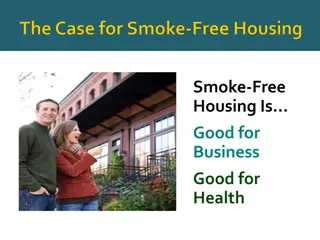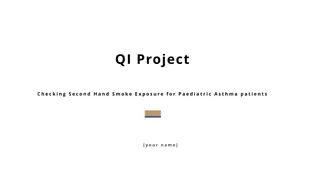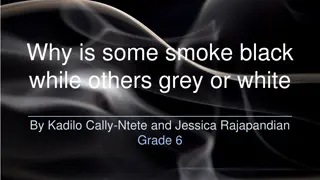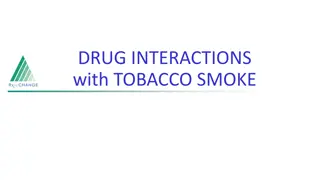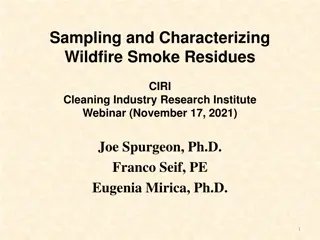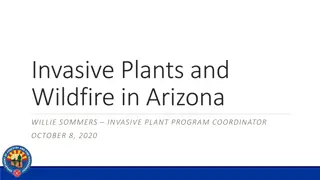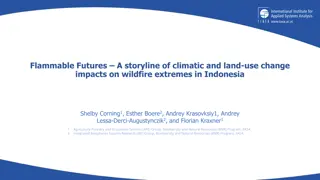Wildfire Smoke Exceptional Events Survey Summary
Survey results indicate that staff across various organizations in 11 Western states possess the expertise to develop wildfire smoke exceptional events demonstrations for particulate matter and ozone. The majority of states express readiness to assist other organizations and seek training to enhance the exceptional events process. However, some states may require further capacity-building in areas such as photochemical modeling and technical advice. No responses were received from Tribal representatives.
Download Presentation

Please find below an Image/Link to download the presentation.
The content on the website is provided AS IS for your information and personal use only. It may not be sold, licensed, or shared on other websites without obtaining consent from the author. Download presentation by click this link. If you encounter any issues during the download, it is possible that the publisher has removed the file from their server.
E N D
Presentation Transcript
Overall summary: 18 total responses* 11 western states Some states had more than one staff member respond. In some cases, staff from both the state and local agencies responded. In one case, two local agencies responded, but note the state. No responses from Tribal representatives were received. WRAP Smoke WRAP Smoke Exceptional Exceptional Events needs and Events needs and feedback survey feedback survey results summary results summary Bob Kotchenruther Bob Kotchenruther WRAP FSWG Co WRAP FSWG Co- -chair Sept. 2022 Sept. 2022 chair Results were grouped to the state level. * Responses collected from 6/28/22 7/22/22 1
Question: Do staff at your agency/organization have the expertise needed to develop a wildfire smoke exceptional events demonstration for PM? 100% said yes on the state level. One local replied no, One local said yes but lacked resources, One state said yes but welcomed trainings that would improve the EE process. 2
Question: Do staff at your agency/organization have the expertise needed to develop a wildfire smoke exceptional events demonstration for ozone. Of the 11 states: Yes No Maybe Tier 1 or 2 O3 9 0 2 Tier 3 O3 8 0 3 Maybe was expressed by those states that had little experience with developing an O3 smoke EE demonstration. In some cases, with multiple responses from a state, if once response was yes, then yes was recorded for the state. 3
Question: If staff at your organization have the expertise needed for developing a wildfire smoke exceptional events demonstration for ozone or PM, would your staff be willing to be contacted by staff at other organizations for advice? If yes, let us know the best point of contact in your organization and whether it is for PM, ozone, or both. Species PM Organization CA South Coast AQMD CA ID MT CO TX NV Clark County Name/POC Scott Epstein Theresa Najita Sara Strachan Brandon McGuire Scott Landis Tim Janke Yousaf Hameed Email sepstein@aqmd.gov; theresa.najita@arb.ca.gov, sara.strachan@deq.idaho.gov bmcguire@mt.gov SCOTT.LANDES@STATE.CO.US timothy.janke@tceq.texas.gov hameed@clarkcountynv.gov O3 CA CO (Tier 1 or 2) TX NV Clark County WA WY AZ Matthew Densberger Scott Landis Erik Gribbin Yousaf Hameed Farren Thorpe Leif Paulson Jonny Malloy matthew.densberger@arb.ca.gov SCOTT.LANDES@STATE.CO.US erik.gribbin@tceq.texas.gov hameed@clarkcountynv.gov fher461@ecy.wa.gov leif.paulson@wyo.gov malloy.jonny@azdeq.gov 4
Question: Do you foresee your organization not having capacity to complete an exceptional events demonstration if you have a regulatorily significant exceptional event? If yes, in what areas do you think you might need assistance, or training, to develop a wildfire smoke EE demonstration? Of the 11 states: No (has capacity) Yes (need capacity) Maybe (need capacity) 5 4 (2 responses specified would need help with O3 Tier 3, photochem. modeling) 2 Specific capacity related requests were: Need photochemical modeling technical advice and or full modeling support. Need trainings on O3 EE development. Need regional coordination to improve the efficiency of EE development, facilitate collaborations, develop a repository of successful EE demonstrations, development of templates. Need additional trainings in remote sensing, trajectory analysis, and statistical methods, regression models and other types of complex analysis. 5
Question: Do you expect to develop exceptional events demonstrations based on regulatorily significant wildfire impacted monitoring data in 2021? Of the 11 states: Yes No Not sure 5 2 4 6
Question: If, for example, the PM2.5 annual NAAQS is lowered to 10 ug/m3 and 2021 is one of the three years of data used for designations, do you expect to need to develop exceptional events demonstrations based on regulatorily significant monitored wildfire impacts in 2021, because of the lowering of the standard? Of the 11 states: Yes No Not sure 3 2 6 7
Question: WRAP has already performed some data analysis for 2021 (see the PowerPoint and Word documents that accompanied this survey). What additional *regional* analysis products would be helpful for developing your 2021 EE demonstrations (e.g., fire specific data and what kind of data, remote sensing data on fire activity and transport, aggregations of supporting information, conceptual model that could be generally used)? All the items listed in the question. Smoke transport modeling with modeled impacts at surface. A tool to easily calculate Q/D for ozone demonstrations. Smoke/fire locations and fire characteristics. More detailed fire analysis linking weather patterns and conditions. Dealing with the Q/D, getting Q is challenging Easily accessible Q/D analysis information, including the 24hr fire emissions in tons per day. A common conceptual model would be helpful, as well as regional summaries of fire activity and smoke transport - for example, a list of what specific fires impacted what regions on what days. This can be cumbersome to track down when fires are in other states or Canada, and each state is likely compiling this information and reinventing the wheel. Conceptual model that could generally be used. More surface and upper air meteorological data in relation to climatological normals would be beneficial. Reanalysis data would also benefit in regions with limited observational data. A day-by-day analysis of fires and expected smoke impacts, HYSPLIT analyses, statistical analyses, perhaps something like the TSS that could help folks analyze/visualize their data. Better emissions data from fires, much of the "canned" modeling is done for the purpose of forecast and not retrospective. 8
Question: In addition to regional products, what *site specific* analysis products would be helpful for developing your 2021 EE demonstrations (e.g., air mass residence times and potential for wildfire emissions to contribute [for examples see: https://views.cira.colostate.edu/tssv2/WEP-AOI/], analysis of photochemical ozone potential and fire s contribution)? Items mentioned in the question plus modeling trajectories. Air mass residence times. WEP/AOI could be helpful, photochemical modeling and expected PM/O3 impacts. Loop in emission inventory, emission factors, coupling emissions results to improve understanding of wildfire emissions. Analysis to show that wildfire emissions affected air quality at a monitor (i.e. analysis to show that wildfire emissions have actually been measured at the monitor). 9
Question: WRAP is looking for ideas on what it could do to help organizations streamline the EE development process. Please provide your thoughts and suggestions. (part 1) We are finding that EE demonstrations tend to be very repetitive, so software can be written to assist. Staff wrote an EE demonstration for the 2020 Bobcat and El Dorado fires (which turned out to not be regulatory significant). This event required the same analyses repeated for several days, so Staff wrote Matlab code to create sections of the EE based on templates. Staff are in the preliminary stages of converting this code into a graphical user interface (GUI) program that can be used to generate EE demonstrations for other events in the future. The EPA needs to recognize these events (and even dust events) are often regional in cause and origin and go beyond an air district boundary, and developing methods to approach it as such would be helpful. Work with EPA regions to see what they all want to generally see. While there's guidance that suggests what products could fill each void, there's no way to know whether it's useful until they've been gathered and analyzed which often takes significant time and manpower to accomplish - which EPA still won't commit to. The only way to convince EPA for demonstration concurrence is by overloading them with a massive number of supporting products and hope you can tie them together in a way that EPA's teams can understand and can't deny. The difficulty is set very high in all but the most obvious situations, and even then documentation demands are overwhelming for many agencies on top of normal planning and technical demands. EPA should reevaluate EE demo requirements. Convince EPA to re-write the ozone EE guidance by either eliminating the Q/D or replace it with a statistical method. 10
Question: WRAP is looking for ideas on what it could do to help organizations streamline the EE development process. Please provide your thoughts and suggestions. (part 2) Be good to have a general outline/template (word, Latex, or google drive document) for each type of EE demonstration. These could be a quick and accessible starting point for developing demonstrations. I think WRAP is better equipped to put pressure on EPA to help change the process rather than to provide detailed analytical support. WRAP can also help SLTs coordinate and work together if they are working on overlapping EEs. I have always thought that there was an opportunity to collaborate with the USFS - Air Resources Advisory group to glean valuable information from them as they're doing real-time recaps/smoke outlooks. I think we could possibly create some type of regulatory recap document that could be shared with the states. Maintain organized archive of potentially useful products, satellite images, HMS smoke plume analyses, daily incident reports, again coordination with EPA would be valuable. TSS style monitoring data repository, clearinghouse for EE demos. Provide a good clearinghouse for information and keep doing what you're doing. Providing clear examples and explanations of performing each analysis associated with the Tier levels for ozone wildfire exceptional events. If there was a repository for wildfire information that organizations could upload information to. This would allow no rework if someone already pulled the information other states could just download it and use it. Ensure that criteria are the same for EEs for each EPA region and organization regardless of size. Would be helpful to understand what EEs have been approved for wildfire and what data sources were used in the EE. What did EPA approve and where can those data be found. 11
Question: At present WRAP has focused on the 2021 fire season. If WRAP were to develop ongoing supporting data for EE development beyond 2021, what product(s) would be most helpful? (part 1) Software (graphical user interface, GUI) for walking people through doing an EE demo. A standard set of code for doing analyses that other agencies can use would also be useful. Making remote sensing and other modeling tools more accessible to districts with limited staff and expertise. Q/D support Atmospheric chemical modeling output for significant wildfire events across the West. Source apportionment/contribution analysis of wildfire smoke to PM2.5 and ozone. It depends on what year DVs are used for designations if/when the PM NAAQS are revised. If 2023 DVs are used, then states will likely need support with 2022 and 2023 EE demos as well. Since the NAAQS for PM and O3 are calculated using 3 year averages, many agencies need to submit EEs for multiple years, not just 2021. Ongoing maintained repository, real-time support, improved process with EPA. Individual wildfire data and associated modelling for Q/D analysis would always be helpful. Monitoring techniques research for specific biomass burning tracers as well as current products. 2020 products. Have wildfire specific data (example: speciation), to better understand what type of emissions are coming from the wildfire directly. Air regulatory agencies do not have the same access to data to support EE demonstrations (example: ozone lidar and sodar). 12
Question: At present WRAP has focused on the 2021 fire season. If WRAP were to develop ongoing supporting data for EE development beyond 2021, what product(s) would be most helpful? (part 2) Maintain organized archive of potentially useful products, satellite images, HMS smoke plume analyses, daily incident reports, again coordination with EPA would be valuable. TSS style monitoring data repository, clearinghouse for EE demos. Provide a good clearinghouse for information and keep doing what you're doing. Providing clear examples and explanations of performing each analysis associated with the Tier levels for ozone wildfire exceptional events. If there was a repository for wildfire information that organizations could upload information to. This would allow no rework if someone already pulled the information other states could just download it and use it. Ensure that criteria are the same for EEs for each EPA region and organization regardless of size. Would be helpful to understand what EEs have been approved for wildfire and what data sources were used in the EE. What did EPA approve and where can those data be found. 13
Question: Would you have any interest in fire impacts analysis not related to EEs, such as clarifying where and when fires are causing elevated monitoring readings that may lead to community health impacts? What data analysis products would be helpful? How exactly would you use these products? Additional or improvement of existing smoke models could be helpful. We look at fire impacts for issuing smoke advisories. At the time of issuing advisories during fires, we typically won t know whether we will need to write an EE demonstration for that event. Any products related to this topic would need to be in real time to be useful. Yes! Any modeling, such as pollutant values, trajectories, and maps and graphics. That could be useful for CARB and air districts. Compiling simple smoke modeling with air quality alerts with email signups by location might be helpful for both districts and community members. Smoke residence time, fire/smoke satellite products, and trajectory analysis. Yes, we have participated in some epidemiology studies that sought to identify which days were impacted by wildfire smoke and which were not. It is difficult to draw a line there, especially at concentrations below the NAAQS when smoke impacts exist but are small. Guidance on how to identify smoke-impacted days even at sub- NAAQS concentrations would be helpful. I think communities in Oregon are already doing some analysis on other fires impacts. Yes. Visual/mapping products that we could share with the public to help inform them where the smoke is coming from. Overlayed weather forecasting information and other layers could also help us with our analyses and communicate with others. Possibly fuel types, emission factors? Have wildfire specific data (example: speciation), to better understand what type of emissions are coming from the wildfire directly. 14
Question: What actions, if any, are your jurisdiction taking with regard to EE development, to plan for more stringent levels of the PM and O3 NAAQS? (part 1) Current levels in the South Coast AQMD are elevated well above the current standards, so it will be many years before we would need to consider EE demos for fire-influenced ozone events. PM: With or without fires, South Coast AQMD will not attain more stringent levels of PM NAAQS for several years. To this point all of our EEs have been high wind dust events, but we continue to monitor any distant fires should we be impacted by wildfire EEs Trying to be aware of major fires and potential impact dates, but there's so many sites it's hard to get ahead of the potential needs. Will most likely be a reactionary response as new NAAQS are enacted due to other workload requiring our attention until then. Evaluate controls as needed, get more resources. Reviewing our capabilities and what resources will be needed to formulate EE demonstrations given the lower PM and O3 NAAQS standards. Collecting supporting information on exceedance days (e.g. alerts and warnings, local news reports, highway webcam images, etc.). We have looked at 2020 and 2021 PM2.5 flagged days to see how many EEs it would take to remain compliant with various NAAQS levels. We determined that if the PM2.5 NAAQS were lowered to 25 or 8 g, no amount of EE demos would keep Pinehurst, Salmon, or St. Maries below the NAAQS. We don't have a set plan besides trying to train additional staff. 15
Question: What actions, if any, are your jurisdiction taking with regard to EE development, to plan for more stringent levels of the PM and O3 NAAQS? (part 2) Starting to look at flagging O3 data. Nothing directly tied to EE development, though our forecasting group has hired a full-time meteorologist to help with these types of analyses. Reviewing and screening for EE's, additional speciated monitoring The Wyoming DEQ-AQD is planning to draft and submit EE demonstrations for PM2.5 and ozone, regardless of possibly more stringent NAAQS. We are aware of the possibility of lower standards and concerned about what it means for creating additional EE s, but we are waiting to see what changes are made to the PM and O3 NAAQS before taking any actions. 16
Question: Please provide any other feedback or suggestions you have regarding WRAPs efforts to support EE development. If the workgroup was interested, we could present some work we ve been doing in writing code and a preliminary version of a graphical user interface (GUI) for creating EE demonstrations. Regional photochemical modeling if appropriate I think the most helpful tool for us, and potentially to other state agencies, is the development of an accessible template/outline for each type of EE demonstration. This would provide an excellent starting point and could simplify the process to some extent by having a base to launch off of. Additional support to have access to data and/or EPA funding for additional data. 17



